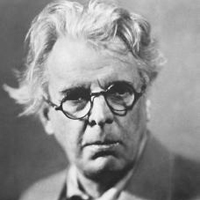Sailing to Byzantium by William Butler Yeats: Introduction
The title “Sailing to Byzantium” suggests an escape to a distant, imaginary land where the speaker achieves mystical union with beautiful, eternal works of art. Byzantium is the old name of Constantinople or Istanbul, which was the capital of the Eastern section of the Roman Empire. It was famous for its mosaic art and metal enameling.

William B. Yeats (1865-1939)
After its conquest by the Turks in 1453, it saw the revival of Greek art and culture. Here in this poem ‘Byzantium’ is a symbol of a country of art and philosophy which transcends the limits of time and nature.
"Sailing to Byzantium" is quite a short poem, consisting of four rather simply put together stanzas (abababcc, all in roughly iambic pentameter). In the first, the poet describes the natural world, where the young of all species - birds, fish, people - are busy loving, reproducing and "commending" the flesh. Though these "generations'" are "dying" from the moment of their birth, they do not notice it. "Caught" in the "sensual music" of life, they "neglect monuments of unaging intellect" - works of art, religion or philosophy, the products of man's non-physical imagination. But what place is there among these young sensualists for an old man whose senses have already begun to fail?
In the second stanza, Yeats describes the old age as a stage in man’s life when he becomes almost incapable of indulging in sensual sensations. He becomes a virtual scarecrow. Unless he betakes himself to the study of art, he is like ‘a tattered coat upon a stick’. The poet, therefore, decides to go to the Byzantium, which is a traditional place of art, and engage himself there with the study of the treasures which the place offers. The poet has called Byzantium “holy”, for it is the center of spiritual and intellectual activity and not a place suitable for physical and sensuous pleasures of life.
In the third stanza poet describes that as soon he arrives in Byzantium, he prays to God's saints to come down from heaven and teach him to appreciate art. The saints are superb artists of Byzantium, who created the "monuments of unageing intellect" and who are supposedly its guardian angels. He sees them with imagination's eye standing in God's holy fire like figures in mosaic work, standing against a background of gold. He invokes them to come down with rapidly spinning motion and teach him how beauty of art is to be experienced and enjoyed. He wants them to become the “Singing masters of his soul” and to purify his heart. In other words he wants them to teach him to listen to spiritual music, as distinguished from the sensual music. The poet after getting rid of all sensual desires would like to be transformed into some object of art having an eternal value.
In the fourth stanza Yeats imagines what this immortality would be like. It is, of course, far from the traditional concept of immortality - angels choiring, etc. This is the heaven of art, where the artist himself becomes the artifact. Yeats has renounced his earthly body, he would not like to re-born in the same or in any other earthly shape. He will reject all physical incarnations, because all living beings are subject to mortality and death. He would like to become something eternal and imperishable. He would take the shape of the golden bird, the kind of bird which Grecian goldsmiths are believed to have designed for the pleasure of an emperor. As a golden bird, a work of art, he would be beyond decay or death and would therefore be unlike the “dying generations” of real birds. As a golden bird, he will be placed on a golden bough, and he will appear to be singing songs of all times to an audience of the lords and ladies of Byzantium. His song, when he becomes a golden bird, will be that of spiritual ecstasy and he will be surrounded, not by the young lovers and other animal creatures of the sexual cycle, but by an audience that is elegant and abstract. In Byzantium, he will have no age; past, present and future are all one there.
Cite this Page!
Sharma, K.N. "Sailing to Byzantium by William Butler Yeats: Introduction." BachelorandMaster, 24 May 2017, bachelorandmaster.com/britishandamericanpoetry/sailing-to-byzantium-introduction.html.
Related Topics
Sailing to Byzantium: Analysis
The Scholars: Critical Analysis
The Theme of Immortality in Byzantium Poems
A Prayer for My Daughter: Analysis
Among School Children: Analysis
Crazy Jane Talks with the Bishop
The Lamentation of the Old Pensioner
He Wishes for the Clothes of Heaven
An Irish Airman Foresees his Death
When You Are Old: Summary and Analysis
William Butler Yeats as a Symbolist
Truth of Human Life in Yeats's Poetry
Yeats and the Romantic Tradition
The Salient Features of Yeats's Poetry
Biography of William Butler Yeats
 |
bachelorandmaster.com |